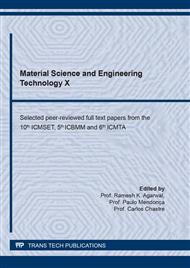[1]
R. Olawoyin, "Nanotechnology: The future of fire safety,, Saf.Sci., vol. 110, pp.214-221.
Google Scholar
[2]
F. Dassenoy, "Nanoparticles as Additives for the Development of High Performance and Environmentally Friendly Engine Lubricants,, Tribology Online, vol. 14, no. 5, pp.237-253.
DOI: 10.2474/trol.14.237
Google Scholar
[3]
H. Hayashi and Y. Hakuta, "Hydrothermal synthesis of metal oxide nanoparticles in supercritical water,, Materials, vol. 3, no. 7, pp.3794-3817.
DOI: 10.3390/ma3073794
Google Scholar
[4]
X. Chen, Y. Yin, J. Lu and X. Chen, "Preparation and properties of iron-based flame-retardant reinforcing agent,, J.Fire Sci., vol. 32, no. 2, pp.179-190.
DOI: 10.1177/0734904113501030
Google Scholar
[5]
Lokesh Srinath Ganapathe, Mohd Ambri Mohamed, Rozan Mohamad Yunus and Dilla Duryha Berhanuddin, "Magnetite (Fe3O4) Nanoparticles in Biomedical Application: From Synthesis to Surface Functionalisation,, Magnetochemistry, vol. 6, no. 4, Jan 01, p.68.
DOI: 10.3390/magnetochemistry6040068
Google Scholar
[6]
P. Karpagavinayagam and C. Vedhi, "Green synthesis of iron oxide nanoparticles using Avicennia marina flower extract,, Vacuum, vol. 160, pp.286-292.
DOI: 10.1016/j.vacuum.2018.11.043
Google Scholar
[7]
A. Ali, T. Shah, R. Ullah, P. Zhou, M. Guo, M. Ovais, Z. Tan and Y. Rui, "Review on Recent Progress in Magnetic Nanoparticles: Synthesis, Characterization, and Diverse Applications,, Front. Chem., vol. 0.
DOI: 10.3389/fchem.2021.629054
Google Scholar
[8]
E. Gkanas, "In vitro magnetic hyperthermia response of iron oxide MNP's incorporated in DA3, MCF-7 and HeLa cancer cell lines,, Open Chemistry, vol. 11, no. 7, -07-01, p.1042.
DOI: 10.2478/s11532-013-0246-z
Google Scholar
[9]
U.T. Lam, R. Mammucari, K. Suzuki and N.R. Foster, "Processing of Iron Oxide Nanoparticles by Supercritical Fluids,, Ind. Eng. Chem. Res., vol. 47, no. 3, -02, p.599.
DOI: 10.1021/ie070494+
Google Scholar
[10]
L. Hu, A. Percheron, D. Chaumont and C. Brachais, "Microwave-assisted one-step hydrothermal synthesis of pure iron oxide nanoparticles: magnetite, maghemite and hematite,, J Sol-Gel Sci Technol, vol. 60, no. 2, Nov, pp.198-205.
DOI: 10.1007/s10971-011-2579-4
Google Scholar
[11]
M. Niederberger and N. Pinna, "Metal oxide nanoparticles in organic solvents: synthesis, formation, assembly and application,,, (2009).
Google Scholar
[12]
L.M. Cursaru, R.M. Piticescu, D.V. Dragut, I.A. Tudor, V. Kuncser, N. Iacob and F. Stoiciu, "The Influence of Synthesis Parameters on Structural and Magnetic Properties of Iron Oxide Nanomaterials,, Nanomaterials (Basel, Switzerland), vol. 10, no. 1, Jan 02, p.85.
DOI: 10.3390/nano10010085
Google Scholar
[13]
A. Rotander, A. Kärrman, L.L. Toms, M. Kay, J.F. Mueller and M.J. Gómez Ramos, "Novel Fluorinated Surfactants Tentatively Identified in Firefighters Using Liquid Chromatography Quadrupole Time-of-Flight Tandem Mass Spectrometry and a Case-Control Approach,, Environ. Sci. Technol., vol. 49, no. 4, -01-22, p.2434.
DOI: 10.1021/es503653n
Google Scholar
[14]
X. Zhang, Z. Bao, C. Hu, J. Li-Shuai and Y. Chen, "Organic pollutant loading and biodegradability of firefighting foam,, IOP conference series. Earth and environmental science, vol. 94, no. 1, Nov 01, p.12137.
DOI: 10.1088/1755-1315/94/1/012137
Google Scholar
[15]
M. Marchetti, M. Offroy, F. Abdat, P. Branchu, P. Bourson, C. Jobard, J. Durmont and G. Casteran, "Chemometrics-Assisted Monitoring in Raman Spectroscopy for the Biodegradation Process of an Aqueous Polyfluoroalkyl Ether from a Fire-Fighting foam in an Environmental Matrix,, Environments, vol. 7, no. 1.
DOI: 10.3390/environments7010004
Google Scholar
[16]
L. Wang, X.C. Fu, Z.M. Bao and X.Z. Zhang, "Study on the Biodegradation of Class a Foam by CO2 Evolution Method,, Advanced Materials Research, vol. 518-523, May 14, pp.525-528.
DOI: 10.4028/www.scientific.net/amr.518-523.525
Google Scholar
[17]
A.V. Vinogradov, D.S. Kuprin, I.M. Abduragimov, G.N. Kuprin, E. Serebriyakov and V.V. Vinogradov, "Silica foams for fire prevention and firefighting,, ACS applied materials & interfaces, vol. 8, no. 1, pp.294-301.
DOI: 10.1021/acsami.5b08653
Google Scholar
[18]
B. Tang, Z. Wu and W. Chen, "Effect of nanosilica on foam and thermal stability of a foam extinguishing agent,, Nanomaterials and Energy, vol. 6, no. 2, pp.67-73.
DOI: 10.1680/jnaen.17.00003
Google Scholar
[19]
B. Long, D. Wang, R. Niu, H. Song, Y. Ma, G. Qu and J. He, "In-situ activation of nano-silica and its foam stabilization mechanism,, J.Dispersion Sci.Technol., vol. 41, no. 1, pp.72-80.
DOI: 10.1080/01932691.2018.1554487
Google Scholar


